Executive Summary
One of the most important aspects of emotional wellbeing is having a feeling of control over one’s time. Indeed, financial advisors often describe one of the benefits of financial planning as helping people take control of their time by giving them the financial freedom to do what they enjoy. And likewise, for advisors themselves, one of the ways to stay happy and thriving is to have the ability to spend time doing what one finds is most valuable or fulfilling.
The 2021 Kitces Research Report on What Actually Contributes To Advisor Wellbeing reinforced the idea that the happiest advisors feel in control over their time. Study data showed that ‘Thriving’ advisors – those who reported high levels of overall wellbeing – spent more time on ‘core’ client activities (such as client meetings and developing financial plans) and less time on other activities like administration and back-office tasks when compared to ‘Struggling’ advisors who reported lower wellbeing. Thriving advisors also worked fewer hours each week than their struggling counterparts, suggesting that they not only spent more time on fulfilling client work but also had more time to devote to fulfilling pursuits outside work.
But it wasn’t just the hours spent on each task that mattered for advisor wellbeing. The amount of autonomy that advisors felt over how they spent their working hours – that is, their ability to choose what tasks they worked on over the day – led to them being able to actually spend their time doing work they enjoyed. And while the ability to enjoy this autonomy might be dictated by some factors (like experience) that are out of the advisor’s control, there are methods that all advisors can use to optimize how they manage their schedule, which could make enough of a difference to see a meaningful improvement in wellbeing.
One strategy advisors can use is time blocking – i.e., blocking off stretches of time in one’s calendar for specific tasks or even for a single project. Creating this focused time not only helps eliminate distractions and inefficiencies caused by frequently bouncing between tasks; it can also make the advisor more efficient and effective at their tasks when they are immersed and engaged in their work without interruption.
There are several ways that advisors can implement time blocking in their work. ‘Theme Days’ give each day of the week a specific purpose, so tasks can automatically be sorted into the day they ‘belong’ to. Alternatively, the ‘Ideal Week’ method incorporates business and personal goals for advisors who want to work less than the traditional workweek. And ‘Surge Meeting’ schedules block off certain months or weeks of the year for advisors to get in all their client meetings, freeing up the rest of the year for other projects or even for time off.
Regardless of the method, time blocking works best when the advisor can remain undistracted by other tasks. This might require some creativity in finding ways to eliminate distractions and organize tasks to ensure they are dealt with at an appropriate time rather than buried in an inbox. Ultimately, though, it may require some fine-tuning (and practice!), time blocking can be the path to achieving greater autonomy – and better wellbeing! – in the year ahead.
Control Over Time Contributes To Financial Wellbeing
In the 2021 Kitces Research Report on What Actually Contributes To Advisor Wellbeing, several factors were found to contribute to advisor wellbeing. However, not many of these factors are within an advisor’s immediate control. While experience matters, newer advisors must wait to attain it, as experience only comes with time. And while being married matters (at least for those who want to be/get married), finding a suitable lifelong partner can take a long time (and as far as I know, the Kitces Summits do not plan to offer match-making breakouts). Employee retention also matters, but much like gaining experience and meeting the right partner, finding and hiring (and keeping!) the right employees is something that can take time; furthermore, while there are steps employers can take to encourage employees to stay, they ultimately have little control over an employee’s actual decision to remain with a firm.
Thriving Advisors Reported Spending More Time On Core Client Work And Less On Other Activities
How an advisor spends their time throughout the workweek also made the list as a contributor to advisor wellbeing. The Advisor Wellbeing survey examined responses from ‘Thriving’ and ‘Struggling’ advisors, and our results found that thriving advisors tended to spend slightly more time on ‘core’ client work (e.g., client meetings, plan development, and investment management), and less time on business development, administration, and back-office client service tasks.
However, unlike other factors that contribute to their wellbeing, such as gaining experience, being married, and retaining employees, advisors have much more immediate control over choosing how to spend their time during the workweek. This is not to say that advisors should strive only to do core client work, nor is it to say that advisors should strive to work more hours so that they can increase their core client work (while maintaining critical business development and administrative activities). The reality is that for many advisors, doing more work might not even be possible, as there are limits to the amount of thoughtful client work that an advisor can do in a week without risking burnout.
Instead, finding the right balance of hours that is most satisfying can be instrumental in increasing an advisor’s wellbeing. As the data show, thriving advisors spend more time meeting with clients than on any other activity, whereas struggling advisors spend the most time preparing financial plans and tending to administrative and client servicing needs.
Furthermore, shooting for a shorter workweek (over time) can offer a more satisfying balance, as struggling advisors tend to work more hours (an average of 45 hours) relative to thriving advisors (with an average of 40 hours) – and with available data on how thriving advisors structure their workweeks, outlined below, advisors have a framework they can use as a baseline as they design their own time-blocking schedules to support their wellbeing!
Importantly, although not explicitly discussed in the Kitces Research report on wellbeing, weekly schedules need to include activities that provide breaks from deep client work. Breaks can be instrumental in helping advisors enjoy their workweek more, along with helping them maintain (and even improve!) their efficiency by increasing focus and relieving stress.
Instead of relying on accrued experience to build greater job satisfaction, all advisors, regardless of whether they are newer or more seasoned, can thoughtfully consider how they allocate their time to support their wellbeing. And there are many tools available to help them actively adopt these strategies now, no matter where they may be in their careers.
Thriving Advisors Report More Autonomy Over Their Work
Another key finding from the 2021 Kitces Research report on wellbeing was that thriving advisors were more likely to feel that they could make decisions about how they work. Feeling in control, organized, and effective are all massively important to wellbeing. Because when work feels out of control, chaotic, and ineffective, especially for prolonged periods, advisors (and all people) are more prone to burnout.
As seen below, struggling advisors felt less appreciated and less effective. They also felt they had less autonomy over their work and that they were not doing work that they were best suited to. Conversely, thriving advisors felt more appreciated, effective, autonomous, and better suited to their work.
Finding Ways To Engage In Deep Work And Flow Can Boost Advisor Wellbeing
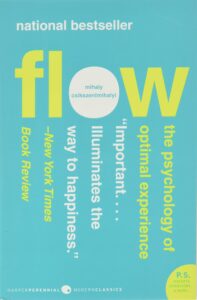 One way to combat the overwhelming feelings associated with disorganized and chaotic workloads is to attain a state of mind referred to as ‘flow’, a concept developed by positive psychologist Mihaly Csikszentmihalyi. While engaged in a flow state, a person is so fully engaged in a particular activity that time may be perceived to melt away, and energy, creativity, and insight expand. Csikszentmihalyi and other flow researchers have found a strong, positive connection between flow and wellbeing.
One way to combat the overwhelming feelings associated with disorganized and chaotic workloads is to attain a state of mind referred to as ‘flow’, a concept developed by positive psychologist Mihaly Csikszentmihalyi. While engaged in a flow state, a person is so fully engaged in a particular activity that time may be perceived to melt away, and energy, creativity, and insight expand. Csikszentmihalyi and other flow researchers have found a strong, positive connection between flow and wellbeing.
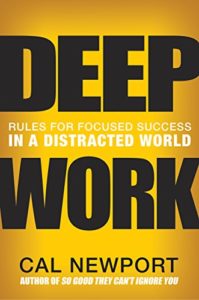 Interestingly, the concept of flow is similar to the idea of ‘deep work’ proposed by computer science professor Cal Newport in his best-selling book on productivity and focus. While the gist of deep work is to deliberately cultivate habits that accommodate prolonged focus for tackling demanding tasks, flow is more about the state of mind one experiences when immersed in an engaging and inherently enjoyable activity. Both flow and deep work can both be highly rewarding; whereas flow tends to be most rewarding in the moment as it is experienced during an activity, deep work tends to be most rewarding with the satisfaction that good work has been accomplished.
Interestingly, the concept of flow is similar to the idea of ‘deep work’ proposed by computer science professor Cal Newport in his best-selling book on productivity and focus. While the gist of deep work is to deliberately cultivate habits that accommodate prolonged focus for tackling demanding tasks, flow is more about the state of mind one experiences when immersed in an engaging and inherently enjoyable activity. Both flow and deep work can both be highly rewarding; whereas flow tends to be most rewarding in the moment as it is experienced during an activity, deep work tends to be most rewarding with the satisfaction that good work has been accomplished.

Nerd Note:
The divide, if one can even call it that, between flow and deep work appears to center around difficulty and enjoyment. Flow has often been described as energizing, rewarding, and a bit euphoric. In his book, “Flow”, Csikszentmihalyi himself described it as “floating”. Deep work, as explained by Newport, can be tough, tedious, and devoid of euphoria, but still fulfilling. Newport says it best in his blog: “Put plainly, the knowledge work community does not yet have the right vocabulary for describing the type of experience I had this morning – an experience that is not suffering, but then again is not immersive flow either”.
However, even though deep work and flow are not the same, they are still related – setting aside time to focus and engage in a particular activity is essential to both. Additionally, the way work is done when engaging with flow and deep work is similar: both involve a high level of focus, a subject limited in scope, and an environment free from distraction. Additionally, both offer forms of immediate internal positive feedback that support a connection to wellbeing.
Cal Newport recently wrote a very interesting op-ed for the New Yorker on the connections between anthropology and the difficulty of modern work, which concludes that we enjoy an immediate (positive) return for work, we need variation in work intensity (because we can’t go 100% all the time – all-day advisor work is not sustainable over long periods of time), and our brains like the challenge of a difficult task.
Experiencing flow and deep work are not necessarily mutually exclusive: On some days, one will enjoy engaging in a flow state, and on others, one will struggle through deep work. And sometimes, one might experience both. The main point is that on all of these days, satisfying work will get done.
Adopting a work style that fits what our brains like – and need – can help advisors engage in deep work and flow to support their wellbeing. But how do advisors actually organize their time to accommodate deep work and flow? One approach is to use time blocking.
How Time Blocking Can Accommodate Deep Work And Flow
For many advisors who have moments where they find open time on their schedule and instantly feel challenged with ‘choice overload’ – asking themselves, “Do I answer client emails? Do I work on a financial plan? Do I work on administration and compliance right now? Should I sneak in a moment to the gym? Or should I be off to a networking event?” – answering the question of what to do can get easier with experience. And most advisors eventually find comfortable workflows to structure their time. However, advisors don’t necessarily need to have years of experience to figure out how to find their flow. Thriving advisors have given us insights into how to structure their time to establish it!
Time blocking involves breaking larger projects and tasks into smaller, more manageable steps and scheduling blocks of time free of distraction, which is a prerequisite for finding flow. It is based on structuring one’s day into discrete periods that focus on particular themes and can even be applied to longer periods (weeks, months, and even years). Time-blocking strategies help by setting rules around how to spend one’s time and by decluttering dedicated periods for specific activities. This can help advisors to be more deliberate about what they do and to make it easier to structure a workable game plan to get things done. It also helps with overall organization, productivity, and creativity.
How time blocks are organized often depends on the difficulty and size of the project. Difficult or sizeable projects may need 3 hours or more to complete, and easier projects might only need one 30-minute time block. The best time-blocking strategies build out blocks that are challenging but not so challenging that no progress can be made. Ideally, the goal is to create blocks where tasks can be accomplished within each defined time block.
Owen Schaffer, professor of computer science at Bradley University, studies enjoyment and flow in digital games and proposed a list of conditions that offer insight into good time-blocking practices, especially those that have the potential to ignite flow. Advisors can consider the following questions, based on Schaeffer’s list, that can help them design time blocks for their own projects and workloads:
- Do you have time that can be set aside for the project? Determine how long the task will take, and set aside the right amount of distraction-free time that will allow for it to be completed. Advisors spend between 7 and 10 hours on a financial plan. So a good strategy for setting time blocks for financial planning would be to create a set of 7 to 10 time blocks that are 60 minutes each to complete the financial plan. These blocks should be devoted only to working on the financial plan.
As the advisor develops the ability to focus and work distraction-free, they may prefer fewer but longer time blocks (e.g., scheduling seven 90-minute blocks over several days), and they may even become more efficient, perhaps requiring only five 90-minute long blocks. Over time, efficiency will inevitably improve, and hours can be shifted as needed; the bigger consideration here is that a block of time has been allocated to a specific task, and the amount of time is appropriate for completing that task. Single blocks of time should be no longer than 90 minutes and limited to a total of 4 hours per day; all blocks should have at least a 15- to 30-minute break in between.
- Do you know what’s involved in the task you set out to do? It’s okay for advisors to be uncertain about what will be needed to complete the task. New projects can take more time, and that might require more time blocks to complete everything. Keeping track of how much time blocking is required initially can help with time blocking more accurately for similar projects in the future.
- Do you know how well you are able to perform the activity? Whether advisors can complete an activity easily or are still learning the basics will impact how efficiently they work. An activity requiring skills that an advisor has not yet fully mastered may require more time blocks. Likewise, new activities may take longer to complete the first few times they are done.
- Do you have freedom from distraction? Time blocks work best when the time set aside is free from distractions, so they should ideally be organized when there won’t be any interruptions. It can also be a good idea for the advisor to communicate to co-workers (and family members) that they will be unavailable during time blocks.
- Do you have the required tools? Ensuring that the requisite tools and information required to complete the activity are available beforehand will help set advisors up for success.
- Do you see potential challenges? Recognizing sticking points and how to address potential challenges – what to do, who to call, what resources to consult – can keep those challenges from compromising flow and deep work.
There are many points of view about how long people can sustain deep work and flow states. Flow states often last for a couple of hours, and deep work is most effective when it doesn’t exceed 4 hours per day. In his book Deep Work, Cal Newport recommends that periods of deep work be structured in increments of no more than 90 minutes each. This suggests that no more than 4 hours of deep, intensive work (which may sometimes be experienced as flow) should be targeted each day, which can mean scheduling no more than 2 or 3 (which would be stretching it!) 90-minute time blocks of intense and highly directed work.
Given this understanding of flow and deep work, advisors might start by structuring their work into 90-minute time blocks. 2 time blocks of 90-minutes each in one day can be devoted to doing deep work – perhaps the blocks can be devoted to preparing financial plans, meeting with clients, or addressing administrative, client service, or staff management tasks. Business development is another area where thriving versus struggling advisors look different, so advisors can also consider creating time blocks for these activities as well.
Implementing A Time-Blocking Strategy For More Wellbeing In 2023
There are 3 popular time-blocking strategies that are practiced by many advisors: theme days, ideal weeks, and surge meetings. Each strategy has its own set of pros and cons that advisors may want to consider as they embark on their own time-blocking journeys.
Theme Days
With theme days, each day of the week is given a different theme (e.g., administration, marketing, financial plans, client meetings) and can help advisors organize their workload. (Our very own Michael Kitces loves using theme days!)
For instance, an administration day might be a theme day where the whole workday is dedicated to completing administrative projects.
Theme Day Pros:
- There is no ambiguity about what needs to be done, which minimizes the possibility of getting distracted by other things that could be done. For example, on Administration Theme Day, we are committed to only addressing administrative tasks.
- Theme days can create consistency; for example, by designating every other Friday as Marketing Theme Day, advisors will become accustomed to the regular cadence of routinely addressing marketing tasks, which will likely help them become more productive and efficient in completing their marketing work.
Theme Day Cons:
- It can take some time to develop a productive cadence and figure out how many particular theme days are really needed in a month or year to optimize productivity.
- Full theme days can be exhausting, as deep work and flow are generally best experienced in shorter periods (not more than 90 minutes for a single activity and not more than 4 hours per day). A full 8-hour day devoted to a particularly challenging theme might be overwhelming and can leave advisors at risk of burnout. So consider no more than 2 time blocks, up to 90 minutes long, of very challenging work with the balance of time composed of less challenging work. All blocks should be separated by 15- or 30-minute breaks.
Ideal Week
Libby Greiwe broke the Financial Advisor Success Podcast charts with her discussion of how she uses an ‘ideal week’ to organize her time! Creating an ideal week relies on an evolving process of time blocking that aims to build out a consistent weekly routine that helps the advisor focus on achieving their most important personal life and work goals.
Advisors can develop their own ideal week by first considering their values and top priorities and then examining how their current responsibilities align with what’s most important to them. Next, aligning actions to match values better may require a deep look at how things are done to identify inefficiencies, times and activities that impact energy levels, and tasks that can be delegated. By gaining insight into these areas, advisors can focus their time on the things that matter most to them, improve processes that are inefficient, and delegate teachable tasks that others can do instead. Then, as activities that make up the ideal week are identified, completed, repeated, and optimized, advisors will find that their work involves more of the things that they love to do, and they become more efficient at getting those things done.
For Libby, her ideal week process helped her learn to rely on strategies to structure her own week and those of her team members, resulting in a practice that she describes as “efficient, effective, and enjoyable”… and involves a workweek of only 25 hours!
Ideal Week Pros:
- This approach encourages advisors to live their best life so they can focus on the things that matter most.
- Ideal week schedules encourage advisors to develop organized and efficient schedules. They help advisors understand what they need to do and how they can do those things efficiently every day.
Ideal Week Cons:
- Learning curves can be steep as the ideal week takes time to build, test, and fully implement. It can also rely on teaching others a process that involves more time and coordination among team members.
- Developing ideal weeks initially requires time and effort, as they involve identifying priorities, addressing inefficiencies, determining how long tasks actually take (with more complex projects that may need to be tracked over long periods), and sometimes planning tasks across teams.
- When delegating tasks to multiple people with an ideal-week approach, each employee needs to know what other employees are responsible for. Coordinating the time blocks with little to no redundancy can take substantial time and effort, at least when first establishing and optimizing schedules.
Surge Meetings
Surge meetings have been advocated by several advisors, including Stephanie Bogan, Matt Jarvis, Micah Shilanski, and Taylor Schulte. They involve creating a schedule that dedicates certain months of the year for client meetings and financial plan updates so that the rest of the year can be spent on other tasks, projects, and even extensive vacations.
Surge Meeting Pros:
- Client meetings and plan updates are organized and efficient.
- Time is allocated for all team members to take care of business while offering ample time off to rest and relax.
- Clients often appreciate surge meeting schedules and rely on meetings that occur twice a year (e.g., before tax season and at the end of the year).
Surge Meeting Cons:
- Surge meetings aren’t a great fit for all personality types. Introverts can find surge meeting months (which can last from 4 to 8 weeks at a time) mentally exhausting and emotionally depleting.
- It may not be the best format for all clients. New clients and those in earlier life phases may prefer more frequent check-ins with their advisors.
Time-Blocking Tools And Communication Strategies
Regardless of the time-blocking methods an advisor might consider, all rely on 2 common factors: the right tools that can support efficiency and protect time blocks from distraction and communication strategies to convey how time blocks need to be respected to accommodate deep work/flow periods.
Because time blocking is best when advisors know how much time something takes, a good starter tool can be as simple as a stopwatch or a simple web-based app like Toggl Track that can track the time it takes to complete each task. While it might be tedious for a week or so, tracking how long tasks take will help advisors design time-blocked schedules that work best for them.
As a starting point, advisors can consider the hourly workweek breakdown reported by thriving advisors as a sample schedule for time-block ideas and adjust as needed based on their own needs and practice. For example, 10 hours per week can be time blocked for client meetings, 7 hours for creating and updating financial plans, 5 hours for investment management, 4 for business development, and the remaining time for all other work. And by tracking the time that tasks take to complete and identifying inefficiencies in their processes, advisors can adjust their time blocks along the way as they improve their focus and become more efficient.
While working without distraction might rely on explaining the importance of quiet time during time blocks to colleagues and family members, it is also something that requires practice. Forest is one app (used by multiple Kitces team members!) that can help keep advisors away from their phones to focus on work, and also sends cute animated rewards.
Calendars may be simple tools, but there is a lot of power in using them. Programs like Microsoft Outlook or Google Calendar can be shared among teammates to communicate and remind everyone of team responsibilities, activities, and meeting dates. While a significant challenge for many involves managing daily minutiae without compromising efficiency, being deliberate about scheduling time, following that schedule, and implementing a system to communicate with others can help keep advisors and their teams on track to focus on their most important priorities.
Scheduling tools like Calendly can also help with any time-blocking strategy by letting advisors designate certain times when meetings can be scheduled. It reframes how scheduling is communicated, achieving greater efficiency by reducing the need to play phone (or email) tag with busy clients to schedule meetings.
Finally, open communication with team members is key to making the most of any time-blocking strategy. While making changes is hard, finding an accountability partner or hiring an assistant can provide advisors with much-needed support in sticking to their planned schedules. Talking with other advisors who also want to improve wellbeing through time-blocking strategies can be an additional source of support and new ideas, providing immediate feedback that can be important in discovering how to achieve flow and productive deep work sessions. And getting teams together to discuss time-blocking strategies so that they can talk about what works best for them can be a great way to start 2023!
Advisors can take a swing at time blocking by starting small and experimenting to find out what works best for them. Perhaps they can try a theme day, and if that goes well (or doesn’t), they can switch out to smaller blocks organized into an ideal week. If a longer-term time-blocking strategy is more appealing, then a surge meeting strategy might work better. Throughout the process, efficiency adjustments can be made along the way, as the right strategy is created over time.
Ultimately, by continually adjusting and fine-tuning their time-blocking processes, advisors can take control of how they use their time and discover what works best for them to leverage flow states and deep work… and how these experiences can lead to greater efficiency and effectiveness. So enjoy the process, because that will support wellbeing, too!


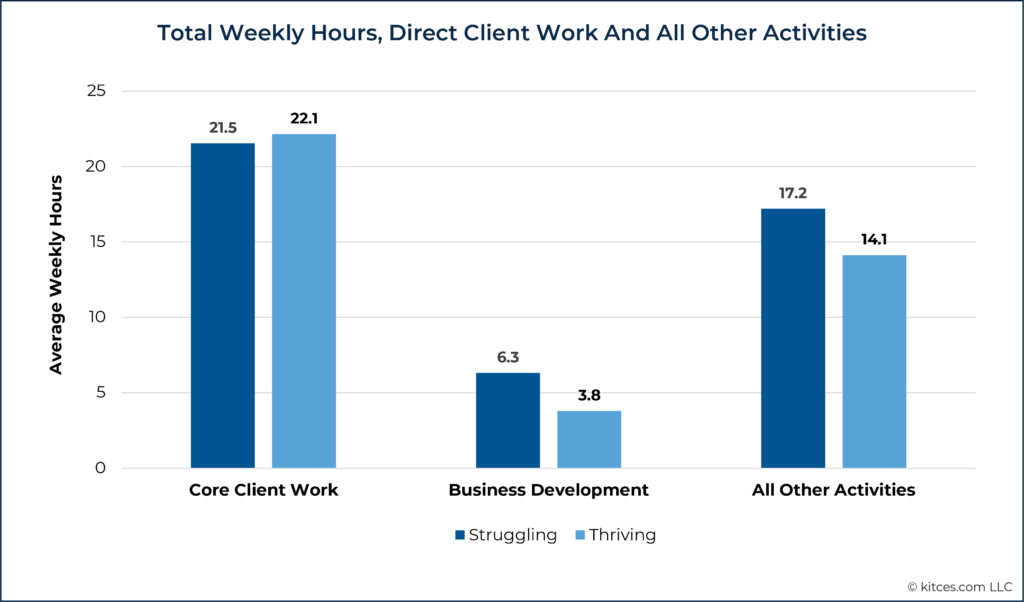
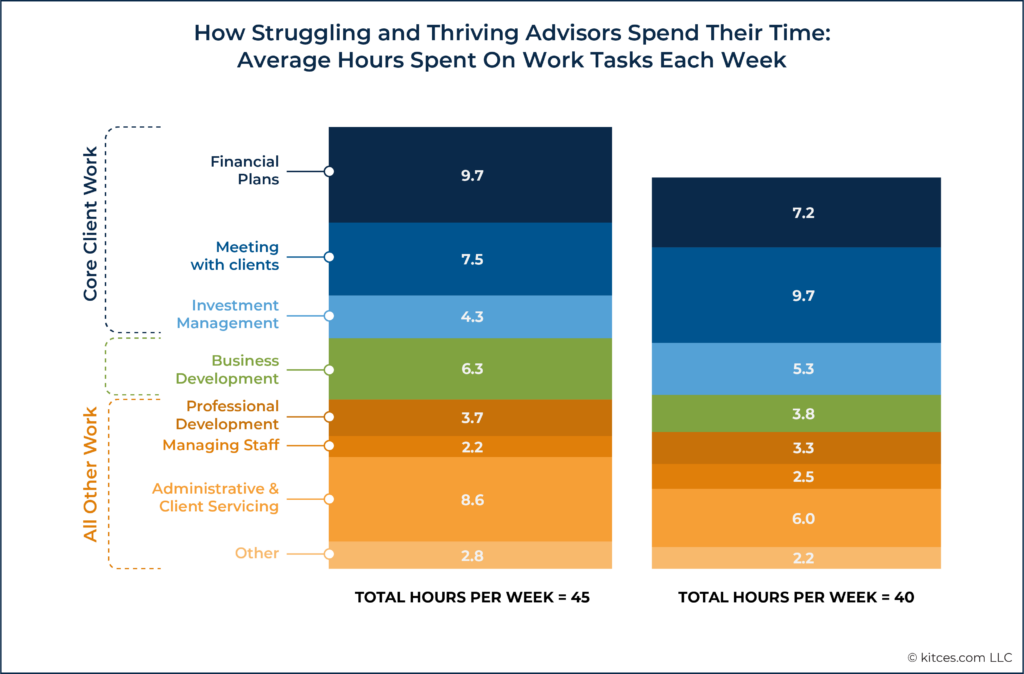
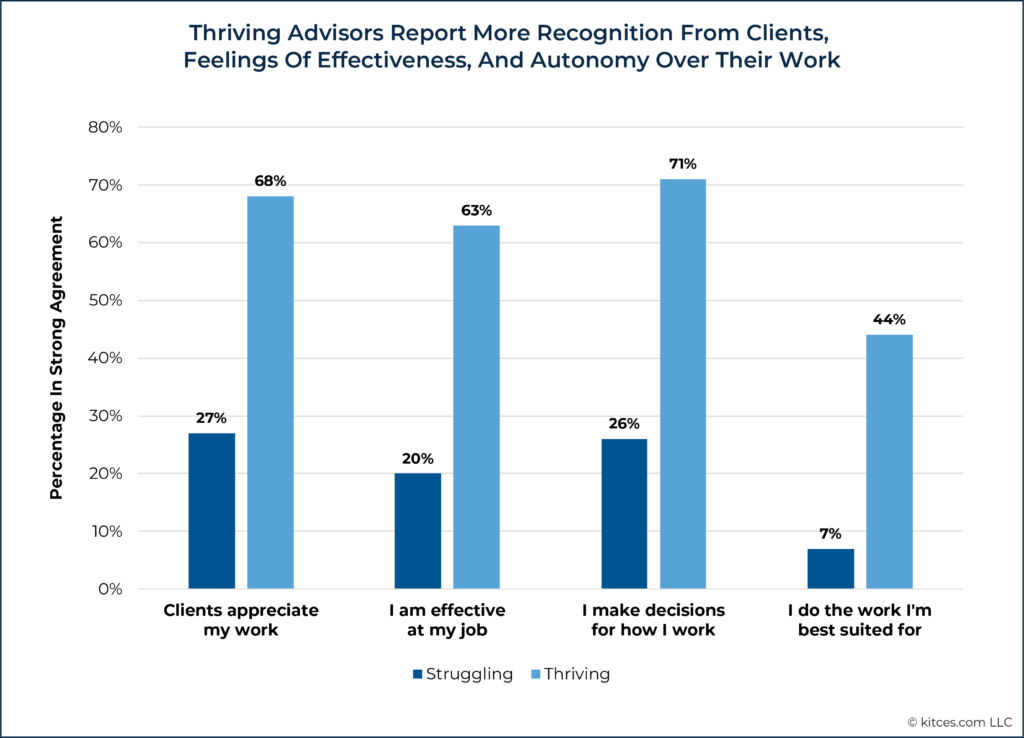



Leave a Reply